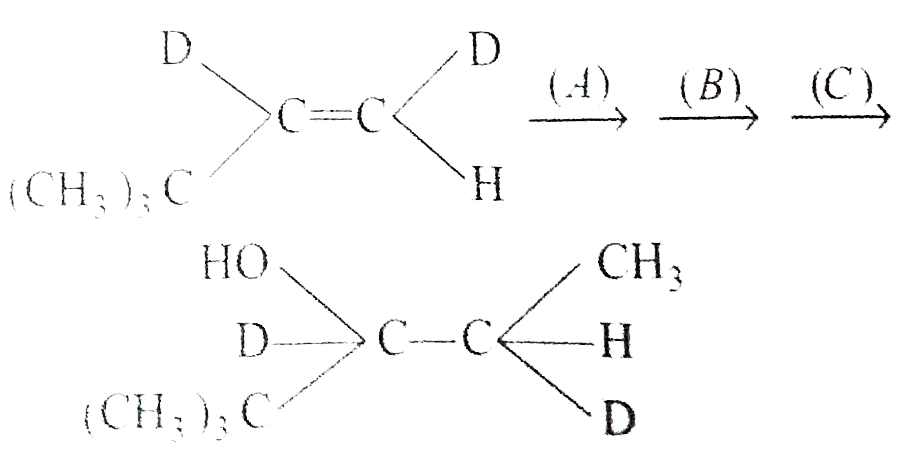CH=CHHgSO4−−−→H2SO4XLiAlH4−−−→Y.
In the above reaction, X and Y are
Ethanal, Ethanol
Ethanol, Ethanal
Ethanal, Ethanoic acid
Ethanoic acid, Acetone
The correct Answer is:A
To solve the given question, we will analyze the reactions step by step.
Step 1: Identify the starting compound
The starting compound is an alkyne represented as CH=CH. This is ethyne (acetylene).
Step 2: Reaction with HgSO4 and H2SO4
When ethyne (CH≡CH) reacts with mercuric sulfate (HgSO4) in the presence of sulfuric acid (H2SO4), it undergoes hydration to form an enol, which can tautomerize to a ketone.
1. The reaction proceeds through the formation of a non-classical carbocation.
2. Water (H2O) acts as a nucleophile and attacks the carbocation, leading to the formation of an enol.
3. The enol then undergoes keto-enol tautomerism to form a ketone.
The product after this reaction (X) is ethanol (CH3CHO).
Step 3: Reaction with LiAlH4
Next, the product X (ethanol) is treated with lithium aluminum hydride (LiAlH4), which is a strong reducing agent.
1. LiAlH4 reduces aldehydes to primary alcohols.
2. Therefore, the aldehyde (ethanol) will be reduced to its corresponding alcohol.
The product after this reaction (Y) is ethanol (CH3CH2OH).
Final Products
- X: Ethanal (CH3CHO)
- Y: Ethanol (CH3CH2OH)
Summary of the Reaction
- The reaction starts with ethyne (CH≡CH), which converts to ethanal (X) upon reaction with HgSO4 and H2SO4.
- The ethanal (X) is then reduced to ethanol (Y) by LiAlH4.
Final Answer
- X = Ethanal (CH3CHO)
- Y = Ethanol (CH3CH2OH)
The starting compound is an alkyne represented as CH=CH. This is ethyne (acetylene).
When ethyne (CH≡CH) reacts with mercuric sulfate (HgSO4) in the presence of sulfuric acid (H2SO4), it undergoes hydration to form an enol, which can tautomerize to a ketone.
2. Water (H2O) acts as a nucleophile and attacks the carbocation, leading to the formation of an enol.
3. The enol then undergoes keto-enol tautomerism to form a ketone.
Next, the product X (ethanol) is treated with lithium aluminum hydride (LiAlH4), which is a strong reducing agent.
2. Therefore, the aldehyde (ethanol) will be reduced to its corresponding alcohol.
- X: Ethanal (CH3CHO)
- Y: Ethanol (CH3CH2OH)
- The reaction starts with ethyne (CH≡CH), which converts to ethanal (X) upon reaction with HgSO4 and H2SO4.
- The ethanal (X) is then reduced to ethanol (Y) by LiAlH4.
- X = Ethanal (CH3CHO)
- Y = Ethanol (CH3CH2OH)
Similar Questions
Ph−C≡C−CH3HgSO4−−−→H2SO4A,
View SolutionComplete the following equations:
a) H2C=CH−CH3+HCl→(A)
b) CH3−CH=C(CH3)2+O3Zn−−→H2O(A)+(B)
c) H2C=CH2+O3H2O−−→(A)NaOH(aq)−−−−−−→(B)+(C)
d) (CH3)3C−CH=CH2+HC<o(A)
d) MeCH2C≡CHNaNH2−−−−→(A)Et.Br−−−→(B)
g) HC≡CHH2,Pd(CaCO3)−−−−−−−−−−→(CH3COO)2Pb(A)Br2−−→Cl4(B)KOH(alc)−−−−−−→(C)
h) HC≡CHHgSO4,H2O−−−−−−−→H2SO4(A)H−−−→LiAlH4(B)concH2SO4−−−−−−→443K(C)
i) CH3CH=(CH2)Br2A773KCl2−−→773K(B)
j) CH3CH=CH2Br2−−→773K(A)KOH(alc)−−−−−−→Δ(B)
k) H2C=CH2+CH2+CH2→(A)
l) CH3CH=CH2+CH2I2→(A)
m) H2C=CH−CH=CH2+H2=CH2→(A)H2−−→Pd(B)
n) C3H7CH=CH2Hg(OAc)2−−−−−−→THF/H2O(A)NaBH4/NaOH−−−−−−−−−→(B)
o) CH3CH=CH2BH3/THF−−−−−−→(A)CH3COOH−−−−−−→(B)
p) C6H5CH=CH2Br2−−→(A)3.0equiv−−−−→CH3I(B)
q) C6H5CH2CH(Cl)C6H5KOH(alc)−−−−−−→Δ(A)
r)

View Solution
Knowledge Check
CH≡ChHgSO4−−−−−−→H2SO4(X)LiAlH4−−−→(Y)
In this sequence of reaction (Y) is,AEthylene bromideBEthanolCEthyl bromideDEthylidene bromideCH≡CH+H2OHgSO4−−−→H2SO4X. In the following reaction X is
AacetadehydeBpropionaldehydeCketoneDethanolC6H5−C≡C−CH3HgSO4−−−→H2SO4A
A_E01_135_O01.png) B
B_E01_135_O02.png) CC6H5−C∣OH=CHCH3DC6H5−CH=C∣OH−CH3
CC6H5−C∣OH=CHCH3DC6H5−CH=C∣OH−CH3
Identity A,B and C in the following reaction
HC≡CHdil.H2SO4−−−−−−→HgSO4Adil.NaOH−−−−−→Bheat−−→C
View SolutionEthyne +H2OHgSO4−−−→H2SO4 Product formed in the given reaction is
View SolutionCH3−C≡CHHgSO4−−−−−−−→dil.H2SO4 product
Product of the above reaction is
View SolutionCH2OCHD2MgI−−−−−−→H3O⊕XConc.H2SO4−−−−−−−→ΔY
In the above reaction compound X & Y respectively will be
View SolutionCH3−Ch2−c=HgSO4−−−→H2SO4, the compound A is
View Solution
